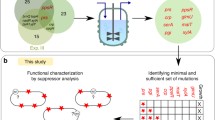Summary
l-Galactose,d-arabinose, andl-fucose form six-membered rings with identical stereoconfigurations. However, onlyl-fucose can serve as the sole carbon and energy source of wild-typeEscherichia coli K-12. A mutant that can grow onl-galactose andd-arabinose was isolated by alternate selection on the two sugars. Thel-fucose pathway became inducible by all three sugars. Transduction into the mutant of the wild-type fuc+ region containing both the regulatory and structural genes abolished the novel growth abilities onl-galactose andd-arabinose, whereas transduction into the mutant of a fuc deletion abolished the growth abilities on all three sugars. Introduction of the wild-type fucR+ (which encodes the activator protein for the fuc regulon) on a multicopy plasmid depressed the growth abilities of the mutant onl-galactose andd-arabinose, but not onl-fucose. The results suggest that the effector specificity of the activator protein in the mutant was broadened. It is proposed that an adaptive response of an activator-controlled system is more likely than that of a repressor-controlled system to achieve fixation in a population, because the first variant to emerge in response to a novel metabolic demand has a good chance of having an altered specificity of regulation. Such a change entails little or no metabolic liability during the absence of the novel substrate. In contrast, the first variant of a negatively controlled system to emerge has an overwhelming chance of being the result of a random mutation that destroys repressor function. Although negatively controlled systems can be more opportunistic in exploiting new conditions than positively controlled systems, an adaptive change is less likely to become fixed because of the cost associated with gratuitous constitutive gene expression in the absence of the substrate.
Similar content being viewed by others
References
Bachmann BJ (1983) Linkage map ofEscherichia coli K-12. Microbiol Rev 47:180–230
Bartkus JM, Mortlock RP (1986) Isolation of a mutation resulting in constitutive synthesis ofl-fucose catabolic enzymes. J Bacteriol 165:710–714
Boulter JR, Gielow WO (1973) Properties ofd-arabinose isomerase purified from two strains ofEscherichia coli. J Bacteriol 113:687–696
Caballero E, Baldoma L, Ros J, Boronat A, Aguilar J (1983) Identification of lactaldehyde dehydrogenase and glycolaldehyde dehydrogenase as functions of the same protein inEscherichia coli. J Biol Chem 258:7788–7792
Camyre KP, Mortlock RP (1965) Growth ofAerobacter aerogenes ond-arabinose andl-xylose. J Bacteriol 90:1157–1158
Chakrabarti T, Chen Y-M, Lin ECC (1984) Clustering of genes forl-fucose dissimilation byEscherichia coli. J Bacteriol 157:984–986
Cocks GT, Aguilar J, Lin ECC (1974) Evolution ofl-1,2-propanediol catabolism inEscherichia coli by recruitment of enzymes forl-fucose andl-lactate metabolism. J Bacteriol 118:83–88
Dische Z, Borenfreund E (1951) A new spectrophotometric method for the detection and determination of keto sugars and trioses. J Biol Chem 192:583–587
Ghalambor MA, Heath EC (1962) The metabolism ofl-fucose. II. The enzymatic cleavage ofl-fuculose-1-phosphate. J Biol Chem 237:2427–2433
Green M, Cohen SS (1956) The enzymatic conversion ofl-fucose tol-fuculose. J Biol Chem 219:557–568
Hacking AJ, Lin ECC (1976) Disruption of the fucose pathway as a consequence of genetic adaptation to propanediol as carbon source inEscherichia coli. J Bacteriol 126:1166–1172
Hacking AJ, Aguilar J, Lin ECC (1978) Evolution of propanediol utilization inEscherichia coli: mutant with improved substrate-scavenging power. J Bacteriol 136:522–530
Hall BG (1978) Regulation of newly evolved enzymes. IV. Directed evolution of the EBG repressor. Genetics 90:673–681
Heath EC, Ghalambor MA (1962) The metabolism ofl-fucose. I. The purification and properties ofl-fuculose kinase. J Biol Chem 237:2423–2426
LeBlanc DJ, Mortlock RP (1971a) Metabolism ofd-arabinose: origin of ad-ribulokinase activity inEscherichia coli. J Bacteriol 106:82–89
LeBlanc DJ, Mortlock RP (1971b) Metabolism ofd-arabinose: a new pathway inEscherichia coli. J Bacteriol 106:90–96
Lerner SA, Wu TT, Lin ECC (1964) Evolution of a catabolic pathway in bacteria. Science 146:1313–1315
Lin ECC (1976) Glycerol dissimilation and its regulation in bacteria. Annu Rev Microbiol 30:35–79
Lin ECC, Wu TT (1984) Functional divergence of thel-fucose system in mutants ofEscherichia coli. In: Mortlock RP (ed) Microorganisms as model systems for studying evolution. Plenum, New York, pp 135–164
Lowry OH, Rosebrough NJ, Farr AL, Randall RG (1951) Protein measurement with the Folin phenol reagent. J Biol Chem 193:265–275
Luria SE, Adams JN, Ting RC (1960) Transduction of lactose-utilizing ability among strains ofE. coli andS. dysenteriae and the properties of the transducing phage particles. Virology 12:348–390
Maniatis T, Fritsch EF, Sambrook J (1982) Molecular cloning, a laboratory manual. Cold Spring Harbor Laboratory, Cold Spring Harbor, New York
Mayo JW, Anderson RL (1969) Basis for the mutational acquisition of the ability ofAerobacter aerogenes to grow onl-mannose. J Bacteriol 100:948–955
Monod J (1947) The phenomenon of enzymatic adaptation. Growth Symp 11:223–289
Mortlock RP (1982) Metabolic acquisitions through laboratory selection. Annu Rev Microbiol 36:259–284
Mortlock RP, Fossitt DD, Wood WA (1965) A basis for utilization of unnatural pentoses and pentitols byAerobacter aerogenes. Proc Natl Acad Sci USA 54:572–579
Old DC, Mortlock RP (1977) The metabolism ofd-arabinose bySalmonella typhimurium. J Gen Microbiol 101:341–344
Oliver EJ, Mortlock RP (1971) Metabolism ofd-arabinose byAerobacter aerogenes: purification of the isomerase. J Bacteriol 108:293–299
Ornston LN, Ornston MK (1969) Regulation of glyoxylate metabolism inEscherichia coli K-12. J Bacteriol 98:1098–1108
Savageau MA (1974) Genetic regulatory mechanisms and the ecological niche ofEscherichia coli. Proc Natl Acad Sci USA 71:2453–2455
Savageau MA (1977) Design of molecular control mechanism and the demand for gene expression. Proc Natl Acad Sci USA 74:5647–5651
Skjold AC, Ezekiel DH (1982) Regulation ofd-arabinose utilization inEscherichia coli K-12. J Bacteriol 152:521–523
Sridhara S, Wu TT (1969) Purification and properties of lactaldehyde dehydrogenase inEscherichia coli. J Biol Chem 244:5233–5238
Sridhara S, Wu TT, Lin ECC (1969) Ferrous-activated nicotinamide dinucleotide-linked dehydrogenase from a mutant ofEscherichia coli capable of growth on 1,2-propanediol. J Bacteriol 98:87–95
Tanaka SS, Lerner SA, Lin ECC (1967) Replacement of a phosphoenol-pyruvate-dependent phosphotransferase by a nicotinamide adenine dinucleotide-linked dehydrogenase for the utilization of mannitol. J Bacteriol 93:642–648
Author information
Authors and Affiliations
Rights and permissions
About this article
Cite this article
Zhu, Y., Lin, E.C.C. An evolvant ofEscherichia coli that employs thel-fucose pathway also for growth onl-galactose andd-arabinose. J Mol Evol 23, 259–266 (1986). https://doi.org/10.1007/BF02115582
Received:
Revised:
Issue Date:
DOI: https://doi.org/10.1007/BF02115582




